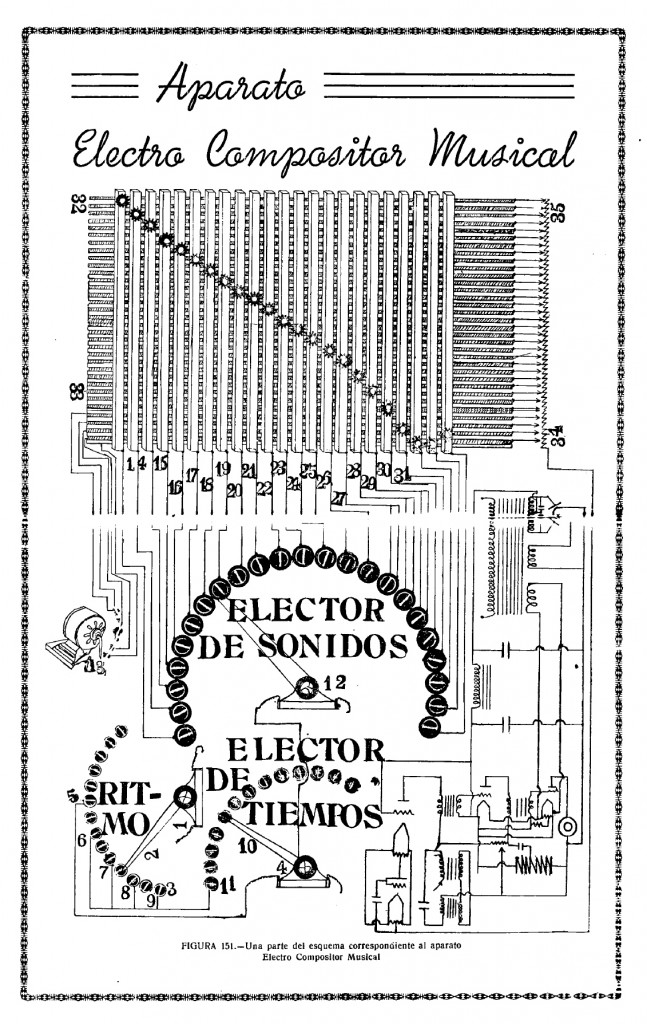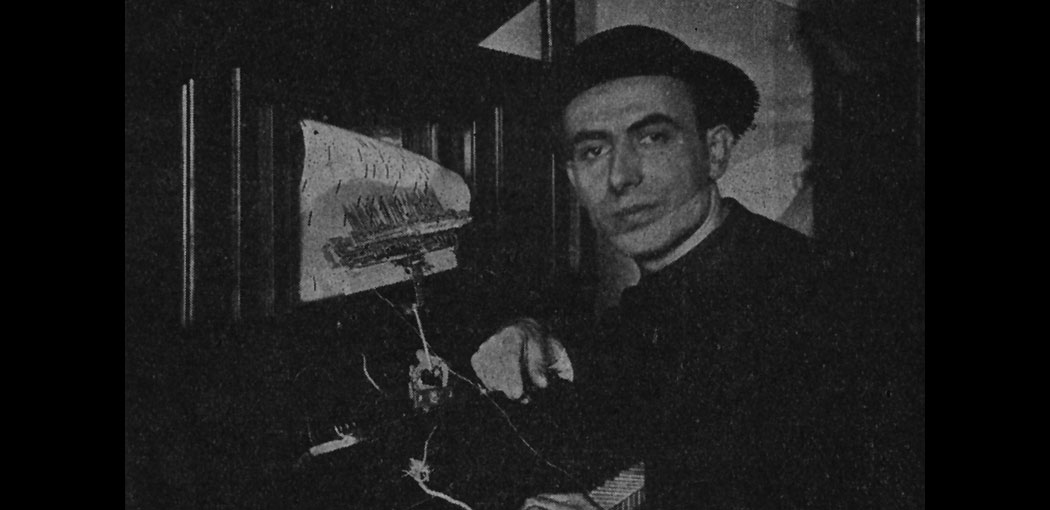Uncertainty Theory #19
Juan García Castillejo and his electrocomposer
AUDIOS
Excerpt from A performative presentation with Caterina Barbieri at Loop 2017.
Excerpt from Rtve's Round Table Power of Sound.
Irregular Vibrations (2012) - Ruben Garcia (in the context of a concert in homage to Juan García Castillejo (Cura Castillejo): 110th anniversary of his birth (1903) and 80th anniversary of the presentation of his Electro Music Composer Apparatus (1933).
This Causes Consciousness To Fracture - Caterina Barbieri (2017) (track 1 - Patterns of Consciousness)
Gravity That Binds - Caterina Barbieri (2017) (track 7 - Patterns of Consciousness)

ELECTROCOMPOSER
On the instrument we clearly identify an upper panel which is used for adjustment and/or programming of the instrument. To the right of this matrix we can see what looks like a set of 23 resistors mounted in series fed at the lower end by a transformer and a rectifier circuit. From the symbology used, these resistors could well be variable, potentiometer type. These series-mounted potentiometers allow us to set a specific voltage on each of the 23 horizontal lines or branches. Then, by means of the vertical displacement of a cursor, we can derive towards 33 possible circuits the "programmed" voltage in each branch. From here it seems obvious that with each of these voltages we act on oscillator parameters by controlling frequency and amplitude. Undoubtedly, the "control panel" proposed by Castillejo is imaginative and, saving the distances, reminds us of the configuration matrices of the analog synthesizers VC-3 (1969) and Synti (1971), both from EMS.
Once solved (or rather, imagined) how the oscillators are controlled, the stage of "spontaneous generation" of music arrives, that is, the control of compositional aspects such as tempo, rhythm, harmonies and other turns of the development of the work. For this purpose, the Electro Music Composer uses a hierarchical mechanism of motors where a master motor, along the path of its axis, selectively closes circuits that activate auxiliary motors responsible for deriving towards the oscillator circuits the voltages that we programmed previously. Castillejo, in the description of the master motor, tells us that it rotates at a speed of 80 rpm and that, along its rotation, it travels a configurable circle of contacts. According to his words "The distribution of these contacts influences the air or genre of music that we pretend that the device executes; well we can distribute them in triangle (compass of 3 by 4), in quadrilateral, pentagon, hexagon etc., inscribed in the circle. When the brush touches these contacts in its path, the circuit of another motor is closed, whose characteristics correspond to those of motors of about 3,000 revolutions per minute". If we take another look at the diagram of the Electro Compositor we clearly see the master motor (labeled #1 Rhythm), sound selector, time selector and note combiner motor (labeled #13). Next Castillejo mentions the existence of a stage -he does not describe it in order not to complicate- of "mechanical vibrators and eccentrics for certain vibrato effects, gurgles, trills, etc.".
Castillejo recognizes that the Electro Compositor has some limitations because "there is an almost insurmountable difficulty in providing very stable voltage to the varied consumption of each moment by the diverse intervention of more minor number of musical notes". In addition we suppose that the inertia during the starting and stopping of the auxiliary motors would induce unwanted sound effects.
After this brief description we can intuit that the Electro Music Composer could be distantly related to a drum machine, or more specifically to the arpeggiator module of a synthesizer. We will always have the doubt of what it sounded like. What there is no doubt about is that the Electro Compositor Musical by Juan García Castillejo is a milestone of electronic technology at the service of music.
Juan García Castillejo was a contributor of ideas as well as technologies. A musical inventor and an artistic visionary.
"The beautiful future of musical art, indisputably, has to concentrate on electrical processes, the results of which will be surprising." Juan García Castillejo.

ABOUT JUAN GARCÍA CASTILLEJO
He was born in Motilla del Palancar (Cuenca), but as a child he moved to live in Valencia. He was passionate about electricity and sound, as well as an inveterate dreamer. In his book Telegrafía rápida y música eléctrica (1944), he himself explains almost all the details about the construction of the "electrocomposer", which was equipped with lamps, transformers, capacitors, resistors, a few dozen loudspeakers and with several motors. "He intended that the perforations of the telegraph tape would be automatically selected by different motors, which would reproduce different recorded sound tracks, so that each book on perforated tape would become a sound book.
His patents had to do with rapid telegraphy and it was from this technological knowledge that he began his proposals for electric music. García Castillejo was a perfect connoisseur of the electric instruments that had circulated in Europe in the immediately preceding decades, such as the teremin, the Martenot waves or the Trautonium. The date of publication of his treatise La telegrafía rápida, el triteclado y la música eléctrica (1944) is usually associated with the chronology of his inventions, but the truth is that these are sufficiently earlier not to underestimate the fact.
We know that in 1933 his main invention, called "musical electrocomposer" was available. It is curious to observe how the Valencian inventor maintains the tradition of secular secrecy of his guild by recognizing that, although the guest invited to the demonstration is a highly qualified person and that, therefore, "for him it would not have been a complicated secret how it worked" (of the "electric orchestra") "the patent procedure obliged us to be sparing in our statements". García Castillejo is careful to distinguish his invention from electric instruments, such as Makhonine's violin. The key is that a loudspeaker is excited by impulses whose origin is strictly electrical. He assures:
The Valencian priest was cautious and feared piracy. Between 1939 and 1943 he registered several patents that he talks about in the above-mentioned book, but without ever showing all the details. Unfortunately, his precautions were not so necessary. García Castillejo did not achieve money, recognition or prestige during his lifetime. "Apparently, when he saw that he was ignored, he put aside his inventions and did not take them up again until his death in the eighties. Frustrated and disappointed, he locked up his machine and never spoke of it again. He devoted himself to being an ordinary village priest." After his death, his own family emptied out all the strange contraptions kept at home by his peculiar uncle and sent them to the junkyard. "They must have been the most surprised when his story was discovered," Delgado says.
One of García Castillejo's main supporters is the prestigious sound art theorist and composer Llorenç Barber, who at the end of the seventies found by chance the manual of Telegrafía Rápida in a bookstore in Madrid. Fascinated by the intellectual and visionary audacity of the old priest, Barber began a process of recovery of his memory. Among other things, he created a "Cura Castillejo" Award to recognize each year the work of the most relevant figures in the field of sound art and experimental music in Spain. Among the academic works that have been interested in this precursor of electronic music, those conducted by the research group of the Intermedia Creations Laboratory of the UPV stand out. Especially the software created by Stefano Scarani to emulate the real functioning of the device. It is inevitable to wonder what face this singular priest would put on when discovering that his inventions have managed to astonish the society of the 21st century.